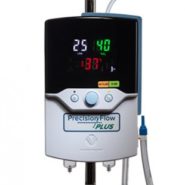Study objective
We compare high-velocity nasal insufflation, a form of high-flow nasal cannula, with noninvasive positive-pressure ventilation in the treatment of undifferentiated respiratory failure with respect to therapy failure, as indicated by requirement for endotracheal intubation or cross over to the alternative therapy.
Methods
This was a multicenter, randomized trial of adults presenting to the emergency department (ED) with respiratory failure requiring noninvasive positive-pressure ventilation. Patients were randomly assigned to high-velocity nasal insufflation (initial flow 35 L/min; temperature 35°C (95°F) to 37°C (98.6°F); FiO2 1.0) or noninvasive positive-pressure ventilation using an oronasal mask (inspiratory positive airway pressure 10 cm H2O; expiratory positive airway pressure 5 cm H2O). The primary outcome was therapy failure at 72 hours after enrollment. A subjective outcome of crossover was allowed as a risk mitigation to support deferment of informed consent. Noninferiority margins were set at 15 and 20 percentage points, respectively.
Results
A total of 204 patients were enrolled and included in the analysis, randomized to high-velocity nasal insufflation (104) and noninvasive positive-pressure ventilation (100). The intubation rate (high-velocity nasal insufflation=7%; noninvasive positive-pressure ventilation=13%; risk difference=–6%; 95% confidence interval –14% to 2%) and any failure of the assigned arm (high-velocity nasal insufflation=26%; noninvasive positive-pressure ventilation=17%; risk difference 9%; confidence interval –2% to 20%) at 72 hours met noninferiority. The effect on PCO2 over time was similar in the entire study population and in patients with baseline hypercapnia. Vital signs and blood gas analyses improved similarly over time. The primary limitation was the technical inability to blind the clinical team.
Conclusion
High-velocity nasal insufflation is noninferior to noninvasive positive-pressure ventilation for the treatment of undifferentiated respiratory failure in adult patients presenting to the ED.


